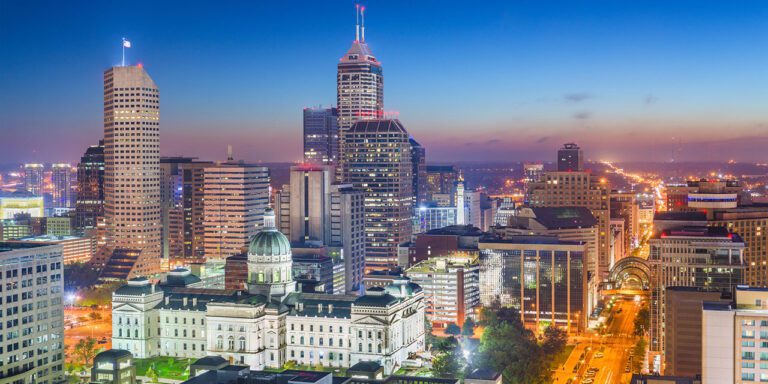 Aaron M. Renn discussed Indianapolis, the future of Midwestern cities and what the press misunderstands about the region with Charles F. McElwee, associate editor of City Journal. Renn is its editor City Journal and economic development columnist for Governance magazine. It focuses on ways to help American cities thrive in an increasingly complex, competitive, and globalized twenty-first century. During Renn's 15-year career in management and technology consulting, he was a partner at Accenture and led multi-million dollar global technology implementations. He writes Heartland Intelligence, a recently launched newsletter focused on the Midwest economy. He lives in Indianapolis.
Aaron M. Renn discussed Indianapolis, the future of Midwestern cities and what the press misunderstands about the region with Charles F. McElwee, associate editor of City Journal. Renn is its editor City Journal and economic development columnist for Governance magazine. It focuses on ways to help American cities thrive in an increasingly complex, competitive, and globalized twenty-first century. During Renn's 15-year career in management and technology consulting, he was a partner at Accenture and led multi-million dollar global technology implementations. He writes Heartland Intelligence, a recently launched newsletter focused on the Midwest economy. He lives in Indianapolis.
How has the Covid-19 crisis affected Indianapolis?
It has created a strange inversion. The streets of New York are usually crowded, while those of Indianapolis are less crowded. But the coronavirus has turned the streets of coastal cities into ghost towns, while Indianapolis' neighborhoods are more alive than ever as people walk and bike.
Of course, this is partly because most people stay home all day. We had similar stay-at-home policies to the rest of the country, but ours are in the process of being lifted.
What does the crisis portend for cities in the Midwest and the Rust Belt?
There's no way to be sure, and I don't think it will be the same everywhere. For cities already deeply troubled, the virus was yet another severe blow. For those who were doing well, it's a reversal, but also a potential opportunity. While the long-term future of coastal cities is bright, Midwestern cities can attract some of the people and businesses that leave the coasts. For many years, they either headed south or toward the mountain west. Whether any Midwest city will become a destination is an open question. But there is a window of opportunity here.
The Midwest plays a critical role in electoral politics. Has the crisis reshaped politics in the region?
I don't think he has. We have seen the same basic divisions repeat themselves. The virus has revealed the situations where division has created particular dysfunction. Wisconsin has developed a uniquely polarized partisan divide. Michigan has seen significant protests. Throughout the crisis, the state government mishandled public policies and imposed strange rules. Out-of-state residents, for example, could drive to their vacation homes, but that policy did not apply to Michigan residents. Illinois is Illinois. Other states seem to be doing much better.
Indiana saw only a small protest against Governor Eric Holcomb. Indianapolis' Democratic mayor and Republican governor got along well and worked well together, even as they chose slightly different timelines for reopening. To date, things have remained functional and remarkably free of hostility.
What does the press misunderstand about the Midwest?
In general, the press tends to ignore the Midwest unless something specific happens to get their attention. It helps if it also fits existing narratives. So we'll hear a lot about bleak post-industrial landscapes or opioids. And the Midwest has both. But we hear much less about the many thriving communities. The press still has a rust belt mentality about the Midwest when the reality, in many cases, has moved on.
The media has also become much more concentrated on the coasts, particularly in New York and Washington. The New York Times it is now a truly national newspaper for the upper middle class. Meanwhile, local and regional media have suffered a major decline and are no longer the stepping stones to jobs in New York as they once were. On the contrary, the Times now uses digital media companies like Buzzfeed as a “farm team”. That can only make it harder for the Midwest to get a good hearing in the press.
What's an overlooked trend right now?
Large corporate employers plan to continue working from home for a long time. These companies are a fixture in the downtown employer base. I fear that many in the inner cities will see a great loss of vitality as businesses suffer from the double whammy of tourism decline and corporate employees moving away. If city centers experience a significant decline in vitality, this, in turn, will affect corporate recruitment downstream and could cause a downward spiral in places that do not respond effectively.
Photo: Sean-Pavone/iStock
I offer
City Journal is a publication of the Manhattan Institute for Policy Research (MI), a leading free market think tank. Interested in supporting the magazine? As a 501(c)(3) nonprofit organization, donations to support MI and City Journal are fully tax deductible as provided by law (EIN #13-2912529).

